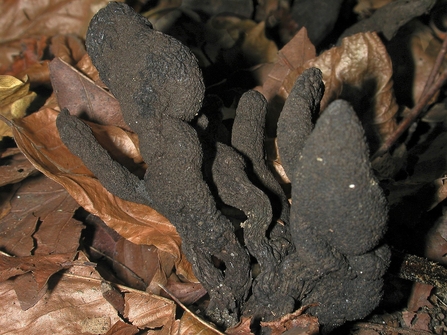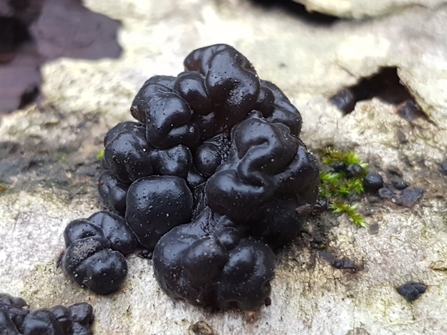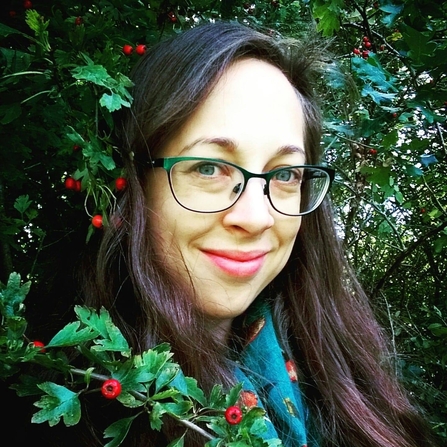Please do not pick fungi in our nature reserves; they are valuable to wildlife and can be deadly when misidentified and eaten.
Fantastical Fungi
Dead Mans Fingers © Les Bins
Autumn may be the time when many of us slow down, but not so for our woodlands. The hedgerows and trees are bursting with seeds and nuts, frantically being gathered by wildlife before winter sets in. You’ll be surprised and enthralled at what you find on your walks, especially when it comes to one of the best of all autumn sights: the delightful fruiting bodies of fungi.
Although they appear year round, fungi become more abundant in autumn’s cool and damp conditions, and fallen leaves provide a fertile base for them to spread. They are a food source for a variety of wildlife, and they also improve the soil by removing toxins and adding nutrients.
You’ll find fungi in any woodland, but here we’ve highlighted two of our favourite reserves and given examples of what you can see there.
Gobions Wood in Brookmans Park, Potter’s Bar is an intriguing reserve – part ancient-woodland, part remnants of an 18th century pleasure garden. It has a diverse range of fungi in autumn, with 558 species recorded onsite. Over 100 of these are rare or scarce in the county.
Amethyst Deceiver © Chloé Valerie Harmsworth
Amethyst Deceiver (Laccaria amethystina) grows here – look for this small jewel nestled in moss, grass or leaf litter. It can appear as a part of a small troop (especially in wet areas) and is often associated with beech and birch trees. It’s called the deceiver because its vibrant violet colour fades with age, making it difficult to identify thereafter.
Orange Peel Fungus © Chloé Valerie Harmsworth
Orange Peel Fungus (Aleuria aurantia) is easy to pass by, looking much like a piece of peel discarded by another woodland wanderer. It grows on disturbed grass, gravel and soil (especially where there are decaying stumps and debris), and therefore can be found next to (and on) well-used woodland footpaths, growing in clusters.
Entry to Gobions Wood is free and the paths are well-established, with some boarded walkways, but please note, certain paths are closed due to concerns over public safety related to Ash dieback.
Astonbury Wood in Aston, near Stevenage is one of our recently-acquired reserves. This precious ancient woodland is recognised nationally as an important site for fungi, boasting 750 species. As part of a Halloween jaunt there, you could keep an eye out for the following creepy characters!
Jelly Ear Fungus © Chloé Valerie Harmsworth
Jelly Ear Fungus (Auricularia auricula-judae) generally grows in clusters on the bark of Elder or Beech trees. Weirdly wrinkled on one side and smoother on the other, it has a disturbingly gelatinous texture and looks just like an ear. Its presence might give you the creepy feeling that the trees are listening to your every word!

Dead Mans Fingers © Les Bins
Dead Man’s Fingers (Xylaria polymorpha) arise like zombie hands from rotting tree stumps and decaying wood in the dank places of the woodland. When young, these fungi are light grey with ghoulish, nail-like whitish tips. As they age, they darken to black. Be careful they don’t grab you!

Black Witches' Butter © tomasp
Black Witches’ Butter (Exidia glandulosa) is black and jelly like in wet weather (with a greasy texture to its surface), but shrinks in prolonged dry weather to cone-shaped, olive-brown crusts. It often grows on dead (but still attached) wood of oak trees. Some historians believe that this fungus was once used to counteract witchcraft, by being thrown onto blazing fires!
Entry to Astonbury Wood is free and there are fairly flat, easy walking routes (although these are narrow in places and can get muddy). Paths link to the local public footpath network.
7th October 2023 marks the 10th anniversary of UK Fungus Day, which celebrates fungi through art and performance, crafts and creations, online talks, quizzes and competitions. Our younger supporters may wish to get involved by downloading our Fungi identification spotter sheet here or delve further into the spirit of Halloween by taking a look at the Top 6 Most Haunting Fungi - yikes!
Please share your fungi sightings and photos by tagging the Trust @hertswildlifetrust on Instagram and Facebook and @HMWTBadger on Twitter.

About the author: Chloé Valerie Harmsworth is the Business Manager at Herts Environmental Records Centre, Herts & Middlesex Wildlife Trust.
She is also a nature writer, artist, editor and photographer. In her work she aims to show the beauty of the natural world and encourage people to protect it. Her first book, The Secret Life of a Woodland Habitat: Life Through the Seasons was published last year. She shares her nature-inspired content on her website and on Instagram @chloevalerienatureart

